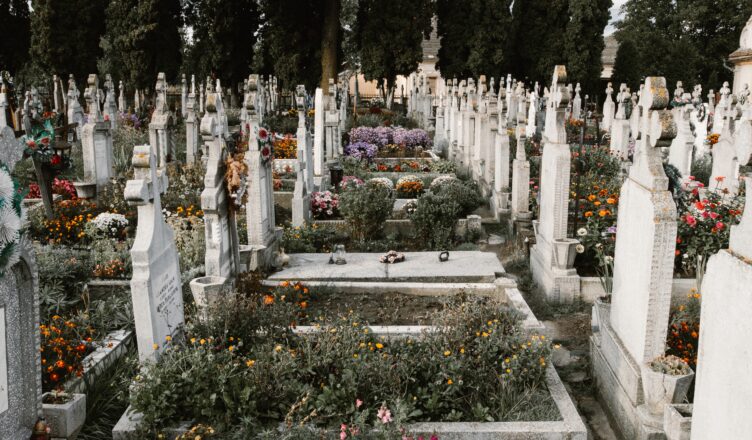Allhallowtide
The Season of Dead Souls and Saints
By Noelle Weaver
While we have widespread Halloween celebrations on October 31st in the US, this popular holiday is followed closely by two holy days in the Roman Catholic church. The Hispanic community’s Day of the Dead or Día de los Muertos has come into pop culture through media like Disney’s CoCo and large public celebrations across November 1st and 2nd. Allhallowtide is an old name for the triduum of holidays; Halloween on October 31, All Saints Day on November 1, and All Souls Day of November 2. The latter feasts celebrate the dead who have passed on. Their roots go far back into ancient and medieval Christianity.
All Saints Day – November 1
The first day of November marks a feast for all of the canonized saints of the church. It is a holy day of obligation, requiring Catholics to attend mass on that day to celebrate.
But who are these people, and what is canonization? According to the United States Conference of Catholic Bishops, “Saints are persons in heaven (officially canonized or not), who lived heroically virtuous lives, offered their life for others, or were martyred for the faith, and who are worthy of imitation.” Simply put, a saint is someone who was so holy during their life, it seems obvious to the living that they must be in heaven after they’ve died.
In the early church, when public martyrs were numerous under the Roman persecutions, the veneration of saints developed organically in Christian circles without regulation. By the sixth century, a bishop’s permission became necessary to authorize sainthood and a cult around the person’s devotion. Saints had become so numerous that to assign a unique feast day to every single one would be impossible. To have a day to celebrate them all, All Saints Day was established in 609 with a church dedication, providing an opportunity to honor the numerous saints and martyrs regarded as holy people
Today, deceased people go through a long and regulated process to be canonized or considered a saint. The Roman Catholic church follows three steps to canonize someone:
- Life examination: Five years must pass after the person’s death before their cause can be looked into by the church. However, in special cases like Pope John Paul II, this waiting period can be waved, as the next pope Benedict XVI did for John Paul II. Similarly to the sixth century, the bishop of the area that person lived in heads the investigation into their life and death. The case is then taken to the Congregation for the Causes of Saints, where it’s reviewed by 9 theologians. A majority consensus on the heroic life and virtues of the person in question pushes their cause to the next step. After this stage, the person is regarded as Venerable. Fulton Sheen, a bishop with a tv program in the 1950s a theologian, recently became Venerable Sheen.
- Beatification: The next step is for a miracle in the name of the venerable person to be performed, investigated, and approved by the Church. The thought is that, if that person is in heaven, the saint can intercede for the prayer and ask a favor for healing or help from God. If they are in heaven, this intercession can be granted. After this step is completed, the person becomes a Blessed. Carlo Acutis, an Italian teenager who died just in 2006, recently passed this step in the last year becoming Blessed Carlo.
- Canonization: When a second miracle in the person’s intercession is approved, the person can become a full fledged saint through canonization. The person achieves the title of saint and can be publicly venerated, in which they gain a feast day, patronage, and prayers for their intercession. Mother Theresa of Calcutta became St. Theresa in 2016, is the patron of World Youth Day, and has feast day on September 5.
All Souls’ Day
All Souls’ Day follows on November 2nd, and is a day of prayer for all dead souls, saints or otherwise. This holiday is celebrated with especial vibrance in Hispanic countries where it’s known as Dias De Muertos. This feast encompasses both All Saints and All Souls Days, and with face paint and masks it also thematically includes Halloween. To Catholics, praying for the dead is incredibly important due to the belief in Purgatory. When someone dies, the theological belief is that most dead souls go first to Purgatory for purification from the consequences of sin before they enter heaven. Souls that go here need prayers in order to be able to ascend to heaven.
This idea of a in-between heaven and hell has captured the imagination of artists for centuries. Dante Aligheri’s Purgatio explores the poet’s imagined version of Purgatory, where the sinful endure tasks and punishment with zeal to atone for their wrongdoings. Dante himself chooses to go through fires to purge himself of his lust with the others who struggle with that particular vice. Today, even the popular CW show Supernatural painted its own depiction of the theological space as the afterlife for monsters.
Allhallowtide
In all, these three days are a celebration of life, death, and what comes in-between. The secular holiday of Halloween is celebrated across the west, while the feast days are each respected by different Catholic cultures in a variety of ways. In secular culture, this time is used to explore the possibilities of life and death, and the monsters lurking in-between.
Sources:
Illes, Judika. Encyclopedia of Mystics, Saints & Sages. October 2011 HarperCollins.
Britannica, The Editors of Encyclopaedia. “All Saints’ Day”. Encyclopedia Britannica, 25 Jul. 2021, https://www.britannica.com/topic/All-Saints-Day. Accessed 2 November 2021.
McBrien, Richard. “The Beatification of John Paul II.” National Catholic Reporter. 7 February 2011. https://www.ncronline.org/blogs/essays-theology/beatification-john-paul-ii
Pierce, Joanne M. “Blessed Carlo Acutis…” 28 October 2018. https://www.americamagazine.org/faith/2020/10/28/blessed-carlo-acutis-first-millennial-saint-catholic-church-children-canonization
https://www.catholic.org/saints/saint.php?saint_id=5611
https://www.nationalgeographic.com/travel/article/top-ten-day-of-dead-mexico






One thought on “Allhallowtide: The Season of Dead Souls and Saints”
Comments are closed.